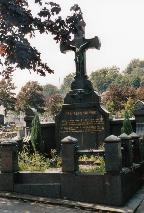Blériot, Louis |
| AVIATION PIONEER (FRANCE) |
|
BORN 1 Jul 1872, Dehéries, Nord-Pas de Calais (near Cambrai) - DIED 1 Aug 1936, Paris GRAVE LOCATION Versailles, Yvelines: Cimetière des Gonards (F - B - 1D - 17) |
|
Louis Blériot studied engineering at the École Centrale in Paris. He invented headlights for cars and selling acetylene headlamps made him a rich man. He took an interest in aircrafts, but the ornithopter that he built in 1900 didn't take off. Together with Gabriel Voisin he started a company that unsuccessfully tried to produce aircrafts between 1903 and 1906. He continued working by himself and in 1909 he created the Blériot XI that was more stable than its predecessors. He wanted to cross the Channel to England to win a prize of 1,000 pounds that was offered by the Daily Mail. His first attempt on 19 Jul 1909 failed and he burnt his foot during a trial. He had two competitiors who also failed in their attempts. On 25 Jul he tried again and with his Blériot XI he managed to reach Dover in 37 minutes. He was a famous man now and produced hundreds of aircrafts until World War I. During the war he produced thousands of SPAD fighter aircrafts for France. After production adventures in England and the USA he retired from flying in 1927. He was there when Charles Lindbergh completed his famous transatlantic flight and they were photograhed together. After he died in 1936 the Fédération Aéronautique Internationale created the Louis Blériot medal. Related persons • met Lübbe, Heinrich |
| Images |
Sources • Adler, Josef, Handbuch der Grabstätten, 2. Band, Die Grabstätte der Europäer, Deutsches Kunstverlag, München, 1986 • The Times • Louis Blériot - Wikipedia (EN) |



